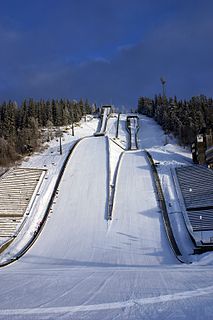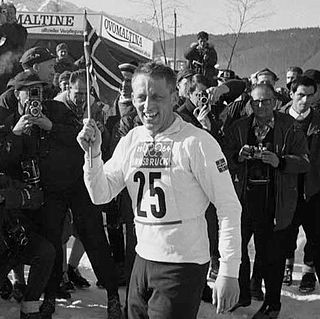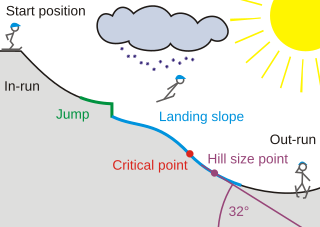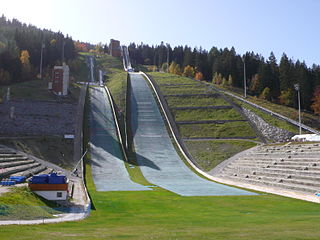
The 1948 Winter Olympics, officially known as the V Olympic Winter Games and commonly known as St. Moritz 1948, were a winter multi-sport event held from 30 January to 8 February 1948 in St. Moritz, Switzerland. The Games were the first to be celebrated after World War II; it had been twelve years since the last Winter Games in 1936.

The 1960 Winter Olympics was a winter multi-sport event held from February 18 to February 29, 1960, in Squaw Valley, California, United States. The resort was chosen to host the Games at the 1956 meeting of the International Olympic Committee (IOC). Squaw Valley was an undeveloped resort in 1955, so the infrastructure and all of the venues were built at a cost of US$80 million between 1956 and 1960. The layout was designed to be intimate, allowing spectators and competitors to reach most of the venues on foot.

The 1964 Winter Olympics, officially known as the IX Olympic Winter Games and commonly known as Innsbruck 1964, was a winter multi-sport event which was celebrated in Innsbruck, Tyrol, Austria, from January 29 to February 9, 1964. The city was already an Olympic candidate, unsuccessfully bidding to host the 1960 Games. Innsbruck won the 1964 Games bid defeating the cities of Calgary in Canada and Lahti in Finland. The sports venues, many of which were built for the Games, were located within a radius of twenty kilometers around Innsbruck. The Games included 1,091 athletes from 36 nations, which was a record for the Winter Games at the time. Athletes participated in six sports and ten disciplines which bring together a total of thirty-four official events, seven more than the 1960. The luge made its debut on the Olympic program. Three Asian nations made their Winter Games debut: North Korea, India and Mongolia.

Alpine skiing at the 1960 Winter Olympics at Squaw Valley, California consisted of six events. Competitions took place at Squaw Peak, KT-22 and Papoose Peak.

Lysgårdsbakken, officially known as Lysgårdsbakkene Ski Jumping Arena, is a ski jumping hill in Lillehammer, Norway. It consists of a large hill, with a K-point of 123 and a hill size of 138, and a small hill with a K-point of 90 and a hill size of 100. It opened in 1993 for the 1994 Winter Olympics, where it hosted the ski jumping and Nordic combined events, as well as the opening and closing ceremonies. After the Olympics, ownership was transferred to the municipal Lillehammer Olympiapark and it has since been used for several FIS Ski Jumping World Cup and FIS Nordic Combined World Cup tournaments, including hosting the Nordic Tournament. It has a capacity for 35,000 spectators and is one of three national ski jumping hills in Norway. In 2007, the large hill was rebuilt to a larger profile, and received a new plastic lining. The venue sees 80,000 annual jumps in the winter and 20,000 in the summer season.
Armin Kogler is an Austrian former ski jumper.

Tormod Kåre Knutsen was a Norwegian Nordic combined skier, who won the Nordic combined event at the 1964 Winter Olympics, and came second at the 1960 Winter Olympics. He won four national championships, and in 1960, he received the Norwegian Holmenkollen Medal.
Nordic combined at the 1960 Winter Olympics consisted of one event, held from 21 February to 22 February. The ski jumping portion took place at Papoose Peak Jumps, while the cross-country portion took place at McKinney Creek Stadium.
Ski jumping at the 1960 Winter Olympics consisted of one event held on 28 February, taking place at Papoose Peak Jumps.

Norway competed at the 1960 Winter Olympics in Squaw Valley, United States.

Austria competed at the 1960 Winter Olympics in Squaw Valley, United States.

The Hochfirst Ski Jump is a ski jumping hill located in Titisee-Neustadt in the state of Baden-Württemberg in Germany. The ski jump is named after the mountain Hochfirst in the Black Forest. It is the biggest natural ski jumping hill. This means that in contrast to many other ski jumping facilities, rather than an artificial tower, the natural gradient of the mountain slope was used for construction.
McKinney Creek Stadium was a temporary ski stadium located at Tahoma, California, in the United States. Built in 1959, it was used for cross-country skiing, Nordic combined and biathlon at the 1960 Winter Olympics in Squaw Valley.
For the 1960 Winter Olympics in Squaw Valley, California, in the United States, a total of five sports venues were used. Except for the Palisades Tahoe, all of the venues had to be constructed. For the first time in Winter Olympic history, a temporary venue was constructed at McKinney Creek for biathlon, cross-country skiing, and Nordic combined. A bobsleigh track was not constructed over the guarantees from the FIBT not being able to field the minimum twelve teams needed to compete, making it the only time bobsleigh has not been included in the Winter Olympics.

The construction point, also known as the critical point, calculation point, calculation line, K-point and K-spot, is a line across a ski jumping hill which indicates the hill's steepest point in meters. It was formerly used to classify the size of a ski jumping hill, and to calculate the number of points granted by a given jump. Since mid-2004, the hills are instead measured in hill size.

Tremplin du Praz is a ski jumping hill at Le Praz in Courchevel, France. The complex consists of four hills: a large hill with construction point of K125 (HS137), a normal hill at K90 (HS96), and two training hills at K60 and K25. The complex also has a cross-country skiing stadium used for Nordic combined. Jörg Ritzerfeld holds the large hill winter record of 134.0 metres and Nicolas Mayer the normal hill record of 100.5 metres.

Igman Olympic Jumps, also known as Malo Polje, is a ski jumping hill on the mountain of Igman in Ilidža, Sarajevo, Bosnia and Herzegovina. It consists of a large hill with a construction point (K-point) of 112 meters (367 ft) and a normal hill with a K-point of 90 meters (295 ft). Construction started in 1980 and the venue opened in 1982 to host ski jumping and Nordic combined at the 1984 Winter Olympics. The large hill event saw Finland's Matti Nykänen set the hill record of 116.0 meters (381 ft) in front of 90,000 spectators. No other International Ski Federation (FIS) sanctioned competitions have taken place at the hills. During the Siege of Sarajevo, the hills became a battleground and have since not been used. However, there are plans to rebuild the in-run, expand the large hill and build new spectator stands and visitor facilities.
Heinrich "Heini" Klopfer was a German ski jumper and architect.
Jim Denney is an American former ski jumper. During his active years, he won the US ski jumping championship in 1976 and 1980, competed in the 1976 Winter Olympics, the 1980 Winter Olympics, the 1978 World championships and won the World Cup normal hill event that year in Lahti, Finland. His hill record of 97.5 m., set at the now defunct Papoose Peak hill venue in Squaw Valley remains the last one recorded for the former Olympic ski jumping installation.














